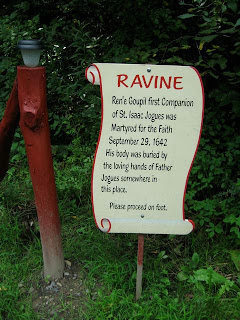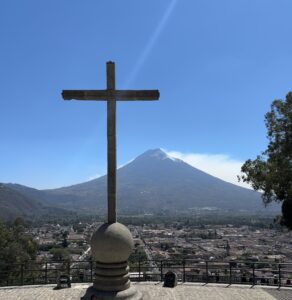by Mary | Oct 22, 2009 | prayer
When I blogged about my unofficial hiatus back in early September, I had hoped it would last no more than a week or two. But here we are, nearing the end of October, and the writing at Not Strictly Spiritual is still sporadic at best. More than a few friends and colleagues have suggested that perhaps it’s time to call it quits on NSS officially. After all, I’m blogging almost daily at OSV Daily Take, and NSS is not “productive” in the worldly sense — it doesn’t bring in money, doesn’t add to my professional portfolio, doesn’t sell my books. But the truth is that NSS is productive, at least for me, in so many other ways.
I can’t give up NSS because I really love being here, talking with you, sharing my spiritual journey (and sometimes my family photos), and hearing about your own faith experiences. I don’t want to give up this blog because, to be quite honest and somewhat selfish, my own spiritual life would suffer for it. Talking about my struggles and my questions and my occasional spiritual “successes,” if we can call them that, is in some ways a form of contemplation for me. I sit and ponder all the things going on in my heart so that I can share something with you. In doing that, I usually discover something about myself and the path I’m meant to be walking.
So….at the suggestion of another blogger-mom-friend Roxane Salonen over at Peace Garden Mama, I am going to take up a regular but not daily blogging routine. I plan to blog here at Not Strictly Spiritual on Tuesdays, Thursdays and Sundays. (Roxane blogs on Mondays, Wednesdays and Fridays, so if you bookmark us both we’ll get you through almost the entire week!)
I actually have so much to share with you and often craft posts in my head but never find the time to write them down in this space. I’m hoping that will all change now with the new schedule. I am still plodding along on my spiritual journey, moving one step forward and two steps back. I’m doing great in the spiritual reading department, not so great in the daily prayer department, and that’s backwards, so I need to flip it around. I have become much more aware of the various things that tug me away from a prayerful attitude and leave me feeling spiritually unfulfilled. Hopefully we’ll get to all that in the coming days and weeks. For now I’ll leave you with a reflection I read before bed last night. It sure hit home for me.
“Resentments cast a cloud over your prayers. This is why Christ told us to leave our offering before the altar and first go to be reconciled with an enemy. If you collect injuries and resentments and think you can still pray, you would probably put water in a bucket full of holes!
“Learn patience, and your prayers will be joyful. Sometimes, even in prayer, something will occur to you that will seem worthy of anger. But anger helps nothing. Think of ways to avoid displaying it.
“…You are crazy if you love prayer and give in to anger or resentment. This is as ridiculous as one who wants to see clearly scratching his eyes. If you desire to pray, stay away from everything that harms prayer. This will clear the path and allow God to walk with you.
“…Much of the time, however, we struggle between prayer and disturbing thoughts. Our emotions get in the way of our prayers. Keep trying. If we knock on the door hard enough, it will be opened.” — Evagrius Ponticus: Chapters on Prayer
Wow, it’s good to be back. That felt good. Stay tuned…I’ll be back with another original post on Sunday (although you may see re-posts of my OSV Daily Take writings in this space on the “off” days.)
by Mary | Oct 19, 2009 | saints

From my post on OSV Daily Take today:
My 12-year-old son had to choose a saint to study for a school project in anticipation of All Saints Day. When I first heard about the assignment, I immediately wanted to suggest St. Isaac Jogues, but I held back and waited to see what Noah came up with on his own. When he came home from school, I asked him which saint he had selected: St. Isaac Jogues. Now, that syncronicity might be remarkable in many circumstances, but Noah has spent two camping retreat weekends on the grounds where St. Isaac Jogues was martyred, so the choice made perfect sense to him, and to me.
When you are a Catholic in upstate New York, only 45 minutes as we are from the National Shrine of the North American Martyrs, Jesuit missionaries St. Isaac Jogues and St. Rene Goupil are part of the landscape. We hear their stories, we walk the ground they walked, we marvel at their courage. Today we celebrate the Feast of the North American Martyrs, remembering those missionaries who died brutal deaths because of their commitment to the Good News.

When you go to the national shrine in Auriesville, which is also the birthplace of Blessed Kateri Tekakwitha, you can walk the ravine and read St. Isaac Jogues’ own words explaining the prolonged torture and terrifying death St. Rene Goupil suffered at the hands of the Iroquois. It was a hatchet blow to the head while Rene Goupil was teaching the Sign of the Cross to children that finally sealed his fate in 1642. Isaac Jogues didn’t fare any better, having survived years of torture and enslavement and having his fingers chewed or burned off. He was killed and decapitated in 1646.
The other Jesuits martyred in North America are Antony Daniel, Charles Garnier, Noel Chabanel, John Lalande, John de Brebeuf, and Gabriel Lalemant.
If you walk the grounds of Auriesville (which I posted about HERE), you can feel a holy presence, a sense that something awful but awesome happened in that place. It is sacred, to be sure. And beautiful.
by Mary | Oct 15, 2009 | Uncategorized
I recently had the privilege of talking with author Anne Rice for an OSV In Focus section on the current vampire craze. Rice’s penchant for all things undead has given way to a very different focus: Christ, redemption, salvation. Check out my interview with Rice in the current issue of OSV, now online. Here’s a taste:
OSV: In an essay on your website, you talk about your work — from “The Vampire Chronicles” through the “Christ the Lord” series — as reflecting your journey through atheism back to God. How is your earlier work part of that spiritual journey?
Rice: As I was writing “Interview with the Vampire,” I knew that I identified with Louis the vampire and that I felt like a creature of the night and a creature who was separated from God and a creature who was lost and pretty miserable. The book is really a meditation on misery, on the misery of being separated from God. I felt very comfortable writing it because it allowed me to express my sorrow. It’s only years later that I realized the book is about the loss of my Catholic faith. It’s about a fall from grace, about leaving the Church, about roaming in the darkness of atheism for many years and feeling as obsessed with God as ever.
Click HERE to read the full interview. And, if you’re interested in the pop culture fascination with vampires, from Dracula to Edward Cullen, click HERE to read what the experts have to say in “Drawn to the Undead.”
by Mary | Oct 4, 2009 | Uncategorized

In honor of the Feast of St. Francis of Assisi, I thought I’d run a recent column I wrote about one of my favorite saints:
Out in my perennial garden, nestled among the stonecrop and candytuft, stands a well-worn clay statue of St. Francis of Assisi made by an artisan in Mexico. The unusual characteristics of the statue make it a conversation piece as well as a spiritual touchstone that helps keep me centered as I dig and weed and plant.
Of course, I’m not alone. Drive down any street and you’re likely to find St. Francis peeking out from both well-manicured lawns and wildflower gardens run amuck. He is just as likely to share a garden with a statue of Buddha as he is to share one with a statue of the Blessed Mother. He is a saint of the people – all people, Catholics and non-Catholics alike. His broad appeal is fascinating, but at the same time it begs the question: Do those of us who plant St. Francis in our gardens really know what the medieval saint was all about?
Today Francis’ concerns are often compartmentalized by well-meaning folks who want to claim him for their own. And who can blame them? He is certainly a challenging but endearing saint for the ages.
Environmentalists jump on Francis’ love for creation, his “Canticle of Brother Sun,” his diligence in protecting trees and even “brother” fire, and find in him a kindred spirit. Animal lovers hear stories of him preaching to birds and taming a wolf and see in Francis the kind of saint who has rightly earned his status as patron of animals. His popularity comes into full view every year at this time, when adults and children alike line up outside churches with everything from goldfish swimming in glass bowls to German shepherds straining at leather leashes just for a chance to get their pets a blessing on Francis’ feast day.
Peace activists, interreligious leaders, social justice organizers — the St. Francis fan club goes on and on. It seems everyone can find a piece of Francis to suit their cause. But, if you put all of those individual causes into the Gospel context that was at the heart of Francis’ rule and spirituality, you come away with a very different picture of our lovable saint, one that is not so easily shaped and molded by the latest trends in activism.
Would those St. Francis lawn statues be as popular if we really stopped to reflect on what they stand for? Francis’ life was one centered on his love of Christ, his commitment to a radical living out of the Gospel, and his “marriage” to the bride he dubbed “Lady Poverty”? The path that St. Francis chose was not an easy one. He was ridiculed and mocked as a madman during his own lifetime for what appeared to be an extreme response to his conversion experience.
He renounced his family’s fortune, fasted for days on end, heard the Lord speak to him from a cross in San Damiano, bore the stigmata. He lived and died for Christ. It would be a disservice to him and all he stood for to try to slip a politically correct mask over the spiritually devout saint who did not do anything halfway.
Sometimes I wonder how I can possibly weave Francis’ difficult and often uncomfortable lessons into my exceedingly comfortable existence. How do those of us with warm homes and busy jobs and nice clothes make St. Francis into something more than a decoration or a mascot? It’s not easy, but maybe, just maybe, seeing St. Francis from the kitchen window as we wash dishes or raking leaves from around his feet as we clean the yard will call us back to our spiritual center and remind us that what we do here on this earth cannot be separated from what we long for in heaven.
by Mary | Oct 4, 2009 | prayer
From my post today on OSV Daily Take:
I was recently drafted onto my parish’s Vocations Committee and decided to join the group for its monthly holy hour for vocations. As we prayed the Rosary in our parish chapel, with various people leading each decade as in the norm, something far outside the norm occurred. I have to admit that I was taken aback by it and still find myself replaying it in my head trying to figure it out.
As we got around to the fifth decade, an older woman a few rows ahead took the lead. I found myself silently startled as she prayed the Hail Mary using the wrong words. I shook it off, attributing it to some sort of brain freeze on her part, and figured we’d resume the normal praying with the next Hail Mary. Wrong. If this was a brain freeze, it was a decade-long freeze. Either that or it was a conscious decision to rewrite this beloved prayer and force the rest of us to come along for the ride.
Here’s how her version of the Hail Mary went:
Hail Mary, full of grace, the Lord is with US.
Blessed is the fruit of your woman, Jesus.
Is it my imagination or did she just demote Mary? In her version of the prayer, Mary no longer has the Lord with her and she is no longer blessed among women.
Now, I have a hard enough time praying the Rosary without this kind of distraction. I found myself trying to race through the correct version of the prayer in my head in time to join the group at the half. Out of the corner of my eye I could see several other women in the back rows looking around for a ref to call a foul. It really was one of the strangest prayer experiences I’ve had in recent memory. It amazes me when someone decides to use a moment of public prayer to make a personal statement, causing an entire chapel full of people to lose sight of what they were doing — praying the Rosary for vocations — and focus instead on the actions of a single person.
So what do you think? Have you heard someone mangle the Hail Mary repeatedly in this fashion before? Is it a slip of the tongue or a not-so-hidden agenda?



